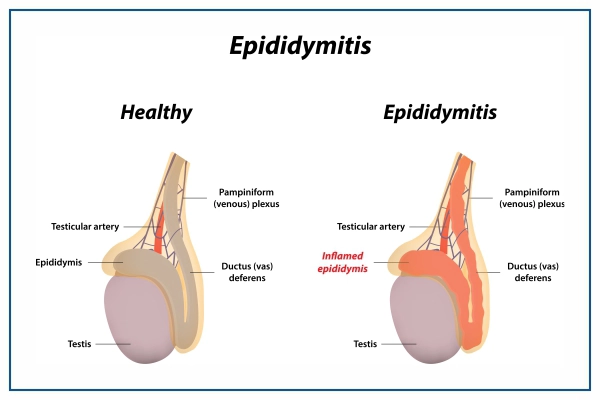Epididymitis: Overview
Epididymitis is an inflammation at the back of the testicle coiled tube (epididymis). Men of any age may develop epididymitis. The most frequent cause of epididymitis is a bacterial infection, which includes STIs like gonorrhea and chlamydia. A testicle can occasionally become inflamed. This ailment is known as epididymo-orchitis.
Epididymitis Symptoms
Epididymitis symptoms and signs include:
- A bulging, heated, or red scrotum
- Testicular soreness and tenderness that often affects one side and develops over time
- Urination that hurts or that is required urgently or frequently
- Discharge from the penis
- Lower abdominal or pelvic pain or discomfort
- A blemish on the sperm
- Fever (less common)
Causes
There are several causes of epididymitis such as
- STIs: The most frequent causes of epididymitis in young, sexually active males are gonorrhea and chlamydia.
- STDs (sexually transmitted diseases): It can also cause Epididymitis.
- Some other infections: Epididymis may become infected with bacteria from a prostate or urinary tract infection. Additionally, viral diseases like the mumps virus can cause epididymitis.
- Chemical epididymitis (Urine in the epididymis): This syndrome occurs when urine backs up into the epididymis, possibly as a result of straining or heavy lifting.
- Trauma: An epididymis injury to the groin can also cause this condition.
Prevention
Practice safer intercourse to help prevent STIs that can lead to epididymitis.
If you have recurrent urinary tract infections or other risk factors for epididymitis, your doctor may go over additional methods of preventing a recurrence with you.
Diagnosis
For the diagnosis of Epididymitis, your doctor will look for larger testicles on the affected side and groin lymph nodes. In order to look for prostate enlargement or pain, your doctor may also perform a rectal exam.
Your doctor may advise the following tests:
- STI examination: To collect a sample of the discharge coming from your urethra, a tiny swab is put into the tip of your penis. It is tested for chlamydia and gonorrhea in the laboratory.
- Blood and urine tests: Your blood and urine samples are examined for anomalies.
- Ultrasound: Your doctor may advise you to have an ultrasound to rule out testicular torsion. If the blood flow to your testicles is higher or lower than normal, it would indicate torsion. Ultrasound with color doppler can assist diagnose this.
Epididymitis Treatment
Both bacterial epididymitis and epididymo-orchitis require the use of antibiotics. In case it is concluded that an STI is the source of the bacterial illness, your partner will also need therapy. Even if your symptoms disappear sooner, you must complete the course of antibiotics ordered by your doctor.
After taking an antibiotic for 48 to 72 hours, you should start to feel better. Pain can be eased by resting, using an athletic supporter to support the scrotum, applying ice packs, or taking painkillers. Your doctor will probably advise a follow-up appointment to ensure the infection has disappeared. If an abscess has developed, surgery to drain it may be necessary. If the epididymitis is brought on by underlying physical problems, surgical removal of the entire or partial epididymis may be required (epididymectomy)

